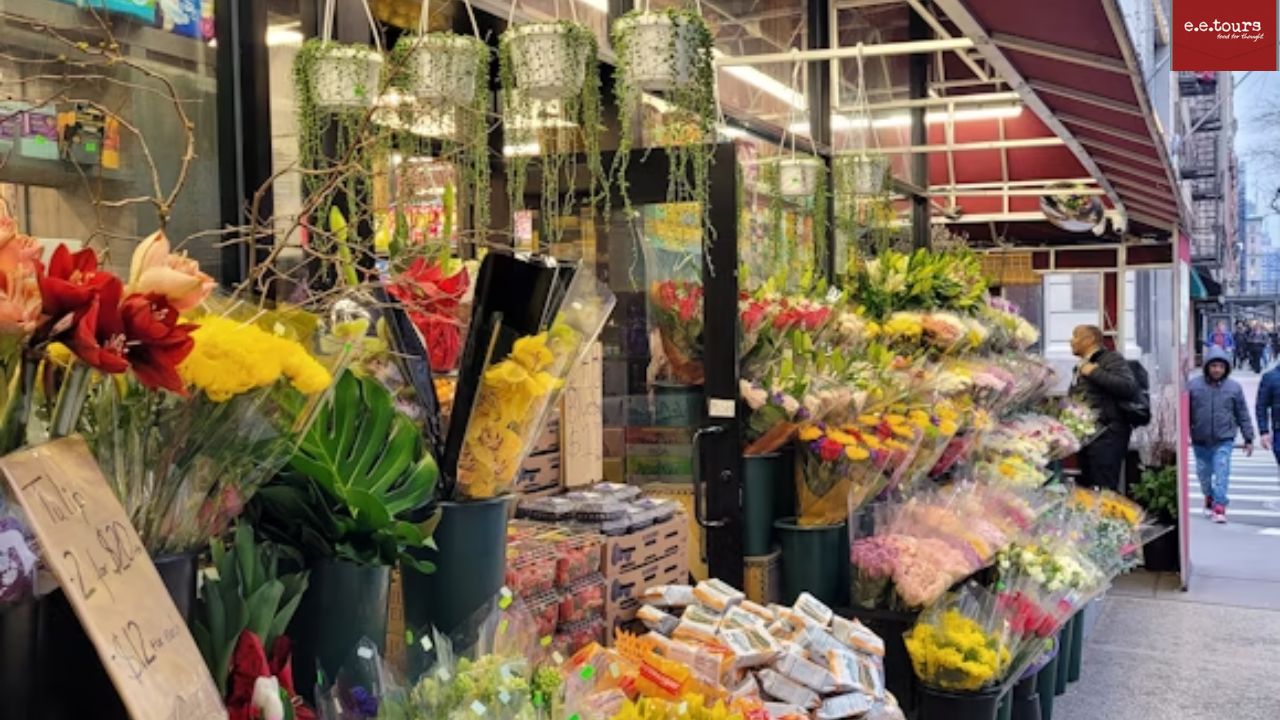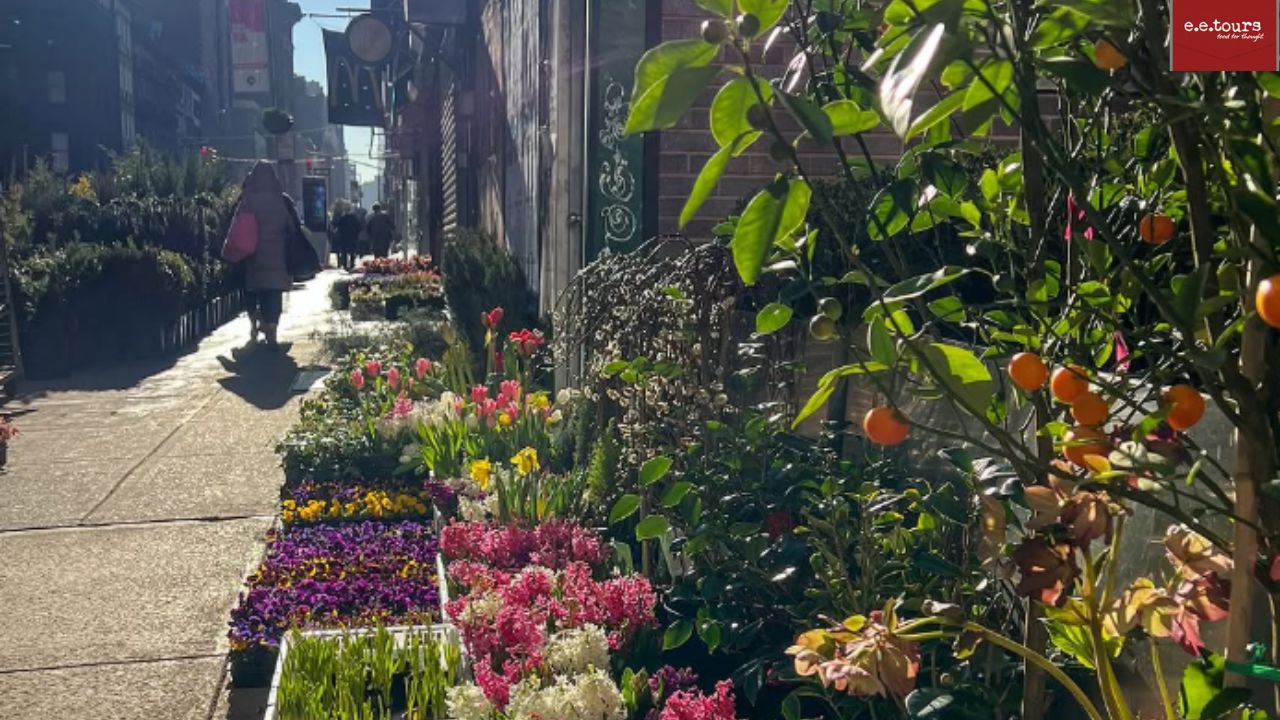The New York Flower Market: A Hidden Gem in the Heart of Manhattan
New York City has a way of surprising you with hidden gems that make you pause and wonder how you missed them. The New York Flower Market is one of those unique NYC experiences, a vibrant wholesale hub tucked away in Manhattan’s Chelsea neighborhood.
Stepping into this world of fresh-cut flowers and lush plants feels like discovering a secret garden amid the city’s hustle; a place where colors pop and fragrances linger, offering a slice of New York’s rich cultural tapestry.
Most New Yorkers walk past this block dozens of times before they actually notice what’s happening here. The New York Flower Market sits on 28th Street between 6th and 7th Avenues. Unless someone is specifically looking for it, they might miss that they are walking through one of the city’s most fascinating wholesale districts.
Where Exactly Is the New York Flower Market?

It’s on West 28th Street between Sixth and Seventh Avenues, right in Manhattan’s Chelsea neighborhood. Turn the corner, and you’re hit with a sensory explosion; buckets of vibrant blooms, fragrant air, and vendors orchestrating a lively dance of commerce.
For those exploring Manhattan’s neighborhoods, this block of the New York Flower Market is a must-visit, revealing a side of Chelsea that pulses with color and history amid the city’s urban rhythm.
If someone needs a specific landmark to punch into their GPS, they can search for “Abraflora Wholesale Flowers” (120 W 28th St) or “Foliage Garden” (113 W 28th St). Either of these will drop them right in the thick of the action.
What strikes most people the first time they visit? They’re standing in the heart of Manhattan, surrounded by towering skyscrapers and the city’s relentless pace. Yet this unexpected oasis of vibrant colours and floral scents creates a rare moment of calm.
The New York Flower Market offers one of those sensory experiences in NYC that feels like a pause button, letting you soak in a world of roses, orchids, and exotic blooms that seem to defy the urban grind.
A Rich History That Shaped NYC’s Floral Industry

The story of the New York Flower Market is anything but ordinary. It didn’t just land on West 28th Street by chance, it grew there through decades of grit and strategy. Back in the 1870s, the market’s early roots were on 34th Street, but by the 1890s, it had settled into its current home in Chelsea.
This shift wasn’t random. During the late 19th century, New York was buzzing with growth, and flower wholesalers saw opportunity in banding together. Trade groups, like the New York Florist Club, pushed dealers to cluster near 6th Avenue, creating a tight-knit hub.
By the 1890s, many had snapped up warehouses between 26th and 29th Streets, forming a vibrant floral district that thrived on collaboration and hustle. It’s a testament to how savvy business minds shaped a corner of the city into something enduring.
What’s fascinating is how they essentially created their own little ecosystem. By the mid-1900s, it had moved to its current location on West 28th Street, where it flourished as a bustling center for wholesale and retail floral purchases.
The Market Today: What Visitors Actually Find
Let’s talk about reality for a moment. The New York Flower Market isn’t what it used to be, and it’s important to set proper expectations. The market used to be home to around 65 vendors. This number is far less now, but some long-standing vendors remain, selling gorgeous blooms.
The district is diminishing slowly because of steadily rising rents. Between 2020 and 2022, the market lost three wholesale companies, two retail storefront companies, and one plant store. That’s the harsh reality of doing business in Manhattan these days.
But here’s the thing, what remains is still absolutely worth anyone’s time. Associated Flowers has been in business at 133 West 28th Street for over 50 years now, and still maintains a wholesale-only operation. These aren’t just fly-by-night operations; these are businesses with deep roots and serious expertise.
Who Shops Here (And Who Can Shop Here)
This is where a lot of people get confused. The New York Flower Market is primarily a wholesale operation. Floral and event professionals buy their wholesale supplies here, but here’s the good news: hobbyists and curious visitors can shop there too.
Customers don’t need a special license or membership card. They don’t need to pretend they’re buying for a wedding business. Regular folks can absolutely shop here, they just need to understand the environment they’re walking into.
These vendors are dealing with professional florists who are buying in bulk and know exactly what they want. So when individual buyers show up, it’s important to be respectful of vendors’ time and processes. Visitors should come prepared, know what they’re looking for, and understand that this isn’t a leisurely browsing experience like they’d find at a typical flower shop.
The Business Side: A Glimpse Behind the Scenes
What really makes this district special is the scale and variety of operations. The New York Flower Group, located in the heart of the New York City Wholesale Flower Market, unifies the companies of Dutch Flower Line, G. Page Wholesale Flowers, and A Rose By Harvest.
These aren’t just local operations either. Once focused on locally grown flowers, vendors now source from around the world. The supply chains these vendors manage are incredibly complex ; they’re working with international suppliers, sourcing new breeders for ever-changing varieties and trends, or working with local organic farms.
Practical Visiting Tips
Some real talk about visiting. The market typically opens early, and that means really early. Some vendors start at 4 AM. By the time most people are having their morning coffee, these folks have already been working for hours.
If someone’s planning to visit as a regular consumer, mid-morning to early afternoon works best. The frantic wholesale rush will have died down, and vendors will have more time to help individual customers.
Also, bring cash. Many of these operations are old-school, and while some accept cards, cash will always make transactions smoother.
And parking? It’s all truck parking until at least 6 pm, long after the market has closed. Taking the subway is the smart move here.
Why It Still Matters
Despite the challenges, the rising rents, the shrinking number of vendors, the pressure from online flower delivery services; the New York Flower Market remains something special. It’s a tangible connection to a different era of commerce, when specialized districts like this were the norm rather than the exception.
More than that, it’s a reminder that even in our increasingly digital world, there’s something irreplaceable about being able to see, touch, and smell what you are buying. When a professional florist is planning a wedding or a major event, they need to see exactly what they’re getting.
The New York Flower Market isn’t just surviving; it’s adapting. The vendors who remain are the ones who’ve figured out how to serve both their traditional wholesale clients and the growing number of individual customers who are discovering this hidden corner of Manhattan.
Next time visitors find themselves in the city, they should take a detour to 28th Street. Even if they don’t buy anything, it’s worth experiencing this unique slice of New York’s commercial history. Just… maybe not during rush hour.